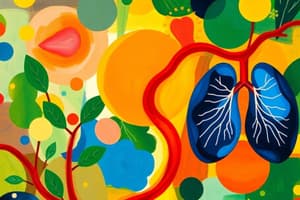Podcast
Questions and Answers
What is the primary purpose of using KOH in the respirometer during the measurement of respiration rates?
What is the primary purpose of using KOH in the respirometer during the measurement of respiration rates?
KOH absorbs CO2 produced by the organisms, allowing measurement of oxygen consumption.
Explain how the Scholander respirometer setup allows for the measurement of respiration rates.
Explain how the Scholander respirometer setup allows for the measurement of respiration rates.
The respirometer measures the movement of a fluid in response to oxygen consumption by organisms in a sealed vial.
Describe how gas exchange principles are demonstrated in the functioning of the Scholander respirometer.
Describe how gas exchange principles are demonstrated in the functioning of the Scholander respirometer.
Gas exchange occurs as organisms consume O2 and release CO2, affecting pressure and fluid levels in the respirometer.
What kind of data can be collected from the Scholander respirometer and how is it analyzed?
What kind of data can be collected from the Scholander respirometer and how is it analyzed?
Signup and view all the answers
How does the pressure difference in the respirometer correlate with the metabolism of the organisms being studied?
How does the pressure difference in the respirometer correlate with the metabolism of the organisms being studied?
Signup and view all the answers
How can the respiration rates of organisms be determined using data collected from a Scholander respirometer?
How can the respiration rates of organisms be determined using data collected from a Scholander respirometer?
Signup and view all the answers
What is the significance of the relationship between volume of gas and moles of gas in respiration experiments?
What is the significance of the relationship between volume of gas and moles of gas in respiration experiments?
Signup and view all the answers
Describe the setup required for using a Scholander respirometer to measure respiration rates.
Describe the setup required for using a Scholander respirometer to measure respiration rates.
Signup and view all the answers
What role does KOH play in respiration studies using a respirometer?
What role does KOH play in respiration studies using a respirometer?
Signup and view all the answers
Explain how the consumption or production of glucose relates to the moles of O2 exchanged during respiration.
Explain how the consumption or production of glucose relates to the moles of O2 exchanged during respiration.
Signup and view all the answers
Study Notes
Objectives
- Illustrate the relationship between photosynthesis and cellular respiration
- Illustrate two different methods of measuring reaction rates
- Investigate conditions necessary for photosynthesis in isolated chloroplasts
- Measure respiration rates in germinating seeds and small animals
Additional Reference Material
- Textbook chapter 8 on Photosynthesis is helpful
Introduction
- Cells in plants and animals have complex structures
- Maintaining this structure requires energy
- Energy is needed for membrane repair, transport of molecules, and protein production
- Cells are distinguishable from their surroundings due to orderly molecular structures
- Organisms need energy and mechanisms to utilize energy for their structure and growth
Autotrophs, Heterotrophs, and Glucose
- Autotrophs use sunlight to produce energy-rich cellular compounds
- Heterotrophs obtain energy from compounds produced by autotrophs
- Glucose (a sugar molecule with carbon, hydrogen, and oxygen) is important for heterotrophs
- Photosynthesis is the light-driven synthesis of glucose and oxygen
- Cellular respiration is the consumption of glucose and oxygen
Equation 1
- Photosynthesis: 6CO2 + 6H2O → C6H12O6 + 6O2 (requires energy from the sun)
- Respiration: C6H12O6 + 6O2 → 6CO2 + 6H2O (liberates energy as ATP)
Chloroplasts and Mitochondria
- Photosynthesis occurs in chloroplasts
- Respiration occurs in mitochondria
- Chloroplasts have a double membrane, and internal thylakoids (grana, lamellae)
- Mitochondria have a double membrane with folded inner membranes (cristae)
- Chloroplast stroma contains the Calvin cycle for glucose production
- Mitochondrial matrix contains intermediates in glycolysis
- Electron transport chain and ATP production occur in the cristae
Measuring Reaction Rates
- Measuring reaction rates is essential in biochemistry and cell biology
- Techniques include monitoring the levels or concentrations of reactants or products
- Variables that influence reaction rates must be controlled or constant
- Examples include: measuring O2 concentration in a closed chamber (manometric) or monitoring the appearance or disappearance of a colored material (colorimetric).
Exercise 1: Examining Respiration Rates
- Scholander respirometer measures respiration rates
- Process measures changes in gas volume due to CO2 production/O2 consumption
- Organisms are placed in a vial with KOH (or NaOH) to trap CO2
- Change in fluid level indicates gas volume change
Exercise 2: Photosynthesis
- Colorimetric method measures photosynthesis rates in isolated chloroplasts
- The chemical indicator changes color as the substance produced by the reaction changes, showing photosynthetic activity
- Spectrophotometer is used to quantify color changes.
- Procedures for preparing cuvettes and handling components have been detailed
Exercise 3: Fluorescence
- Chlorophyll absorbs light and re-emits it at a different wavelength (fluorescence)
- Fluorescence can be a method used to study the processes of photosynthesis
- Preparing a chloroplast suspension is essential for this procedure
Exercise 4: Observation of Cellular Organelles
- Mitochondria: Present in liver cells as small, dark blue dots
- They are involved in cellular respiration.
- Chloroplasts in parenchyma cells (plant cell tissue) are visible as small green granules within the cytoplasm
- Cytoplasmic streaming is a movement of cytoplasm and chloroplasts within cells
Studying That Suits You
Use AI to generate personalized quizzes and flashcards to suit your learning preferences.
Related Documents
Description
This quiz explores the relationship between photosynthesis and cellular respiration, highlighting how energy is utilized by both autotrophs and heterotrophs. It includes questions on measuring reaction rates and investigating conditions for photosynthesis. Perfect for reinforcing your understanding of Chapter 8 in your biology textbook.



